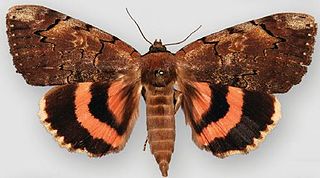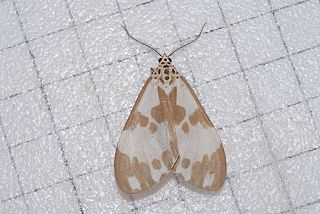
In probability theory and statistics, variance is the expected value of the squared deviation from the mean of a random variable. The standard deviation (SD) is obtained as the square root of the variance. Variance is a measure of dispersion, meaning it is a measure of how far a set of numbers is spread out from their average value. It is the second central moment of a distribution, and the covariance of the random variable with itself, and it is often represented by , , , , or .
"Carissima" is the alma mater of Hamilton College, words and music by M. W. Stryker in 1872.
The Prix de Malleret is a Group 2 flat horse race in France open to three-year-old thoroughbred fillies. It is run at Saint-Cloud over a distance of 2,400 metres, and it is scheduled to take place each year in late June.

Catocala cara, the darling underwing, is an moth of the family Erebidae. The species was first described by Achille Guenée in 1852. It can be found in the United States east of the Rocky Mountains; it occurs west at least to Oklahoma and north at least to Illinois. It also ranges into southern Canada, but only barely so.
"Carissima" is a piece for small orchestra by the English composer Sir Edward Elgar.

Catocala carissima, the carissima underwing, is a moth of the family Erebidae. The species can be found from Florida through Georgia to Texas.

Nyctemera formosana is a moth of the family Erebidae first described by Charles Swinhoe in 1908. It is found in Taiwan.

Nyctemera carissima is a moth of the family Erebidae first described by Charles Swinhoe in 1891. It is found in China, north-eastern India, Nepal, Thailand, Malay Peninsula, Indonesia and Myanmar.

Cremnosterna is a genus of longhorn beetles of the subfamily Lamiinae, containing the following species:
Oxygonia carissima is a species in the beetle family Cicindelidae. It is found in Ecuador.
Mastax carissima is a species of beetle in the family Carabidae found in Myanmar.
Cremnosterna alboplagiata is a species of beetle in the family Cerambycidae. It was described by Stephan von Breuning in 1935.
Cremnosterna alternans is a species of beetle in the family Cerambycidae. It was described by Stephan von Breuning and Itzinger in 1943.
Cremnosterna laterialba is a species of beetle in the family Cerambycidae. It was described by Stephan von Breuning in 1936.
Cremnosterna parvicollis is a species of beetle in the family Cerambycidae. It was described by Charles Joseph Gahan in 1895.
Cremnosterna plagiata is a species of beetle in the family Cerambycidae. It was described by White in 1858. It is known from Myanmar, Malaysia, India, and Thailand.
Cremnosterna quadriplagiata is a species of beetle in the family Cerambycidae. It was described by Stephan von Breuning in 1940. It is known from India.
Lesbates carissima is a species of beetle in the family Cerambycidae. It was described by Dillon and Dillon in 1945. It is known from Brazil.
Carissima is a Venezuelan telenovela written by Julio César Mármol and produced by RCTV in 2001. The telenovela lasted 103 episodes and was distributed internationally by RCTV International.






